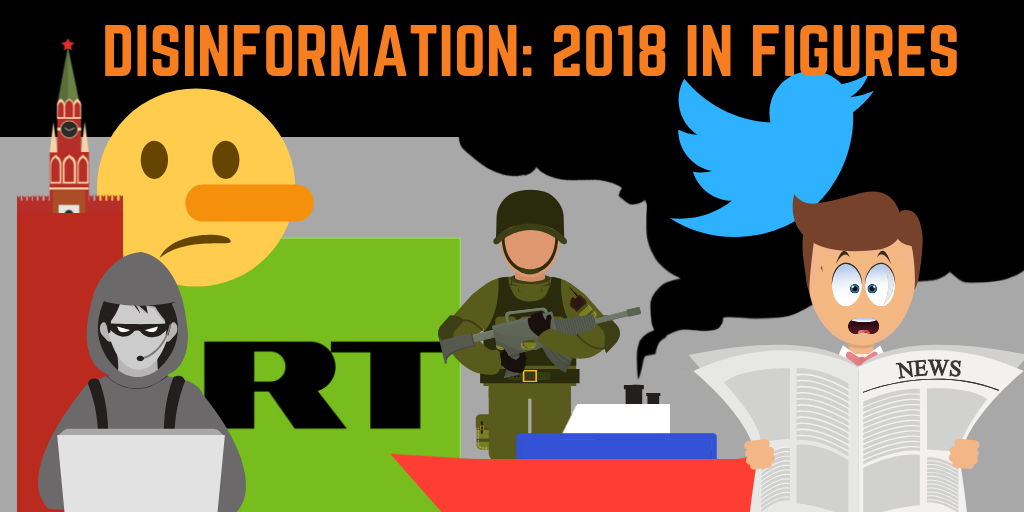2018 has been a busy year for the pro-Kremlin disinformation campaign, with Russian trolls and media working hard to spread falsehoods on an ever-widening range of issues.
A Good Year For The Trolls
Russian internet trolls, for example, appear to have thrived in 2018.
Disinformation Topics: Something Old, Something New
In terms of narratives, the Russian disinformation campaign continued to focus heavily on eastern Ukraine and Crimea.
Read also: Ukraine-related narratives dominate Russian propaganda – disinformation watchdogs
In Crimea, fake stories included the alleged construction by Ukrainian authorities of a 120-kilometer waterway aimed at isolating the annexed peninsula from mainland Ukraine. In eastern Ukraine, Russian media falsely claimed that Ukrainian forces killed 10,000 people in areas controlled by pro-Russian separatists and that 14 instructors had been dispatched by the US secret services to help Kyiv poison water supplies in Donbas. Russian media continued to push the narrative that Ukraine discriminates against Russian speakers, reporting for example that Ukraine doesn’t have a single Russian-language school when in fact the capital city, Kyiv, alone has 16. NATO, MH17, and the alleged dangers of vaccination also remained pet topics for Russian trolls, media, and authorities. The Russian foreign ministry accused Washington of failing to provide a single satellite image related the downing of flight MH17 over eastern Ukraine in 2014, although the United States had in fact publicly released images just five days after the tragedy. As in previous years, Russian media actively sought to discredit NATO, falsely reporting for instance that 7 German pilots quit their country’s armed force in protest at a “NATO military campaign against Russia.” As for vaccination, a whopping 93% of tweets on the issue come from malicious accounts. 2018 also brought Russian disinformation agents new topics to co-opt for their campaigns. The poisoning of former Russian spy Sergei Skripal and his daughter on British soil, for example, generated a barrage of false claims and accusations. EUvsDisinfo recorded more than 20 different, at times conflicting narratives related to the attempted murder of the Skripals. As previously, the impact of disinformation campaigns was difficult to assess, although journalists and pollsters did provide some indications. Pervasive disinformation in Russian state media certainly appears to be bearing fruit with domestic audiences. According to the country’s independent Levada pollster, only 3% of Russians believe Moscow poisoned the Skripals and 46% of Russians know nothing about the Prague Spring events. In Britain, even respected media outlets were fooled by pro-Kremlin disinformation. An investigation by the Guardian showed that British media outlets had republished tweets from Russian trolls more than 100 times since 2017, including BuzzFeed, the Guardian, the Telegraph, the BBC, the Daily Mail, and the Daily Express.Western Pushback
This year, growing awareness of pro-Kremlin disinformation has prompted a number of Western governments and organizations to fight back.
Read also:
- Ukraine-related narratives dominate Russian propaganda – disinformation watchdogs
- Russian online disinformation started targeting US in 2013
- Russian talk shows as progapanda tool: showing dissenters as disloyal citizens
- Russia’s long-term disinformation plan for the Azov Sea
- How we defend ourselves against the disinformation virus: NYT series final episode
- Russian wave of disinformation from the Azov Sea
- Heavyweight megaphones of Russian disinformation in Eastern Ukraine
- Putin’s cook Prigozhin linked to attacks on Putin critics, bloggers
- Only 3% of Russians say they believe Moscow poisoned Skripal
- US indictment sheds light on the Russian troll factory instruction system
- Top three ways Russia spreads disinformation about NATO military exercises

